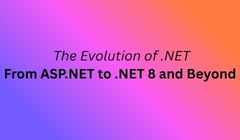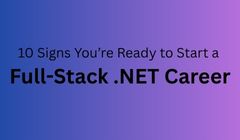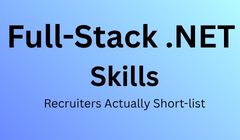
If you’re involved in software development, training, or curriculum design, understanding how .NET has evolved isn’t just a history lesson it’s essential. It helps you align projects, explain migration paths, and prepare learners for what the industry truly demands today.
In this comprehensive guide, we’ll explore:
The origins - from .NET Framework and ASP.NET
The shift - .NET Core and the reasons behind it
The unification - .NET 5/6/7 and “just .NET”
The current - .NET 8 and why it matters
What’s next - .NET 9, .NET Aspire, and the cloud-native future
What this evolution means for developers, learners, and training programs
FAQs - practical migration and career guidance
The .NET journey began in 2002 with the .NET Framework, which introduced a managed runtime (CLR), base libraries, and C# as a first-class language. It enabled developers to build Windows desktop apps, web apps, and services.
ASP.NET, also released in 2002, powered dynamic server-side web development using Web Forms, later ASP.NET MVC, and Web API.
Powerful ecosystem for Windows-based development.
Mature libraries and strong Visual Studio tooling.
Deep enterprise adoption.
Windows-only platform no cross-platform support.
Monolithic architecture heavy applications with complex dependencies.
Deployment and versioning challenges often called “DLL Hell.”
Limited cloud-readiness difficult scaling for modern architectures.
These challenges set the stage for a major transformation: the rise of .NET Core.
Microsoft launched .NET Core in 2016 to make the platform open-source, modular, and cross-platform.
Enable development across Windows, Linux, and macOS.
Improve performance and modularity.
Encourage community collaboration via open source.
Support cloud-native and containerized applications.
Cross-platform development became standard.
Docker adoption increased among .NET teams.
Developers moved from monolithic systems to distributed microservices.
Curriculums began emphasizing DevOps, containers, and cross-platform tools.
For training institutes like NareshIT, this shift meant revamping course material to include Linux, Docker, and cloud deployment in .NET training modules.
With the release of .NET 5 in 2020, Microsoft unified the fragmented ecosystem (.NET Framework, .NET Core, and Xamarin) into one platform simply called .NET.
One base class library and unified runtime.
Common platform for web, desktop, mobile, and IoT.
Predictable annual release cycle.
LTS (Long Term Support) versions for enterprise stability.
.NET 6 (2021) became a major LTS release, improving performance, APIs, and productivity. .NET 7 (2022) followed with non-LTS updates that enhanced minimal APIs and modern architecture support.
Simplified decision-making: developers no longer needed to choose between multiple .NET flavors.
Training programs could standardize on one unified stack.
Migration from legacy .NET Framework gained momentum.
New features like records, pattern matching, and minimal APIs improved developer experience.
Released in November 2023, .NET 8 is the latest LTS version and represents Microsoft’s strongest commitment to performance, scalability, and cloud-readiness.
High performance: faster startup, optimized JIT/AOT compilation.
Cross-platform improvements: seamless containerization and cloud integration.
Front-end innovation: enhanced Blazor modes, static rendering, and SPA support.
Modern architecture: improved support for microservices, observability, and minimal APIs.
C# 12 language updates: improved pattern matching and record struct features.
LTS versions ensure stability for enterprise projects.
Projects built on .NET 8 align with 2025 job market expectations.
Curriculums should highlight modern features cloud deployment, observability, and full-stack Blazor integration.
To build future-ready .NET skills, explore the NareshIT Full-Stack .NET Developer Course designed around modern versions, projects, and placement outcomes.
The .NET roadmap doesn’t stop at 8. .NET 9, expected in late 2024, will deepen integration with AI and cloud-native systems.
.NET Aspire: Microsoft’s new initiative for building cloud-native apps efficiently.
AI and ML integration: using services like Azure AI or OpenAI APIs within .NET apps.
Serverless computing: lightweight functions for event-driven systems.
AOT compilation: smaller, faster, and more efficient executables.
Cross-cloud support: seamless deployment across Azure, AWS, and GCP.
Training programs should include cloud-native design, microservices, and container orchestration.
Learners should build projects using Azure Functions, Kubernetes, and observability stacks.
Blazor and full-stack C# applications will continue to gain traction.
The .NET platform is evolving continuous learning is non-negotiable.
Upgrade from legacy .NET Framework to .NET 8 or newer.
Build real-world, deployable projects using modern stack + cloud.
Learn to speak in migration terms: “I upgraded from .NET Framework 4.6 to .NET 8 for performance and cross-platform support.”
Update the curriculum to include ASP.NET Core, EF Core, Docker, and Azure.
Introduce migration modules to help students understand legacy modernization.
Encourage project-based learning: full-stack app + deployment + monitoring.
Highlight your courses as “Evolution-ready .NET training for 2025 careers.”
Include Blazor as a front-end option alongside React or Angular.
Use version tracking (e.g., “Full-Stack .NET Developer – Built with .NET 8”).
Modern recruiters look for .NET 6/7/8 + Cloud/Containers.
Legacy-only experience is no longer competitive.
Interview questions now include architecture, CI/CD, and observability.
Q1: Is .NET Framework still relevant?
Yes, for legacy maintenance rolesbut new projects should use .NET 6/7/8. Focus your learning on modern .NET to stay competitive.
Q2: What happened to ASP.NET Web Forms and MVC?
Web Forms is deprecated; MVC evolved into ASP.NET Core MVC and minimal APIs.
Q3: Should I migrate from .NET 6 to .NET 8?
Yes. .NET 8 is an LTS version with performance and security advantages.
Q4: Should I learn Blazor or React/Angular?
Learn one mainstream front-end framework (React/Angular) and explore Blazor to differentiate yourself.
Q5: How hard is migration from .NET Framework to .NET 8?
It depends on app complexity. Start with small modules, refactor dependencies, and containerize gradually.
Q6: What should modern .NET 8 projects include?
Minimal APIs or ASP.NET Core MVC
EF Core or Dapper for data access
Docker and CI/CD pipelines
Cloud deployment (Azure/App Service/AKS)
Logging, tracing, and metrics
Modern language features (C# 12)
Clear architecture documentation
Q7: Why does this matter for developers in India?
India’s IT ecosystem is rapidly modernizing. Recruiters in Hyderabad, Bangalore, and Pune now demand .NET Core + Cloud proficiency, not legacy skills.
The journey from ASP.NET to .NET 8 represents more than just version upgrades it’s a transformation from Windows-only systems to cross-platform, cloud-native, and high-performance architectures.
For institutes like NareshIT, this evolution reinforces the need for updated, project-driven, and version-tracked training.
For developers and learners, embracing .NET 8+ ensures you stay employable, adaptable, and ready for next-generation roles.
Modern .NET is about speed, flexibility, and impact whether you’re building APIs, deploying to Azure, or exploring AI integration.
To start your journey toward becoming a modern .NET developer, explore NareshIT’s Full-Stack .NET Training Programme designed to help learners build real-world, cloud-ready, and career-optimized .NET applications.

So, you’re eyeing a future as a Full-Stack .NET Developer a smart move. The .NET ecosystem in 2025 is modern, cross-platform, cloud-ready, and widely trusted by both startups and enterprises. But how do you know if you’re truly ready to take the leap?
This guide highlights ten practical, career-tested signs that show you’re not just interested you’re prepared. You’ll also find self-checks, actionable steps, and a roadmap to move from learning to hired.
A Full-Stack .NET Developer builds complete, end-to-end web applications using the Microsoft technology stack and related tools.
Front-end: HTML/CSS, JavaScript or TypeScript with React or Angular or Blazor if you prefer using C# on the front end.
Back-end: ASP.NET Core for APIs and business logic, with dependency injection, middleware, configuration, and security.
Data: SQL Server or PostgreSQL with Entity Framework Core or Dapper for database operations.
Cloud/DevOps: Docker for containers, GitHub Actions or Azure DevOps for CI/CD, and deployments to Azure App Service or AKS.
Security & Observability: Identity, JWT, OAuth2, logging with Serilog, and monitoring with Application Insights.
You don’t have to master everything on day one, but you should be comfortable working across layers to ship features independently and collaborate effectively.
You understand how a request moves from the browser to the backend and back to the UI including routing, validation, caching, and logging.
Action Step: Draw the flow for a simple “Create Order” feature and annotate where each layer fits.
You’ve built projects that connect React, Angular, or Blazor with ASP.NET Core APIs.
Action Step: Build a CRUD app like “Task Manager” with login, list view, and persistent storage.
You understand EF Core tracking, migrations, and query performance and when to switch to Dapper.
Action Step: Optimize a slow query; compare performance metrics before and after.
You plan, design, build, and test features end-to-end rather than coding in isolation.
Action Step: Take one user story e.g., “Update profile photo” and deliver it from UI to deployment.
You’ve set up pipelines that build, test, and deploy automatically.
Action Step: Add a GitHub Actions pipeline to your project and deploy to Azure App Service.
You’ve implemented JWT authentication, input validation, HTTPS, and secure secret management.
Action Step: Store sensitive data in Azure Key Vault and add refresh tokens to your demo app.
You collect logs, metrics, and traces to understand your application’s behavior in production.
Action Step: Integrate Serilog and Application Insights to track performance and set alerts.
You value simplicity first and can justify when microservices are necessary.
Action Step: Write an ADR explaining why you started with a clean monolith and how you’d scale later.
Your GitHub includes deployed projects with documentation, architecture diagrams, and metrics.
Action Step: Ensure each repo has a README, screenshots, setup guide, and demo link.
You can explain why you chose Blazor vs React, EF Core vs Dapper, or App Service vs AKS.
Action Step: Record a short walkthrough of your project architecture and decisions.
Phase 1 - Foundations (4–6 weeks)
C#, OOP, async/await, LINQ
ASP.NET Core basics (controllers or minimal APIs)
Web fundamentals (HTTP, JSON, HTML, CSS, JS)
Mini project: “Notes API”
Phase 2 - First Full-Stack App (6–8 weeks)
React/Angular/Blazor deep dive
EF Core migrations and relationships
JWT-based authentication and role policies
Project: “Task Manager” with tests
Phase 3 - Ship It (6–8 weeks)
Dockerization, CI/CD with GitHub Actions
Azure App Service deployment
Serilog + Application Insights monitoring
Project: “E-commerce” or “LMS” app
Phase 4 - Differentiate (ongoing)
Performance optimization, profiling, caching
Clean architecture and CQRS
AI integration (e.g., Azure Cognitive Services)
For complete mentor-led training, explore the NareshIT Full-Stack .NET Developer Course designed for real-world readiness and placement success.
“Designed and shipped an ASP.NET Core + React storefront; reduced checkout latency by 42% through caching and EF tuning.”
“Containerized services and built GitHub Actions pipelines; cut release time from 45 to 8 minutes.”
“Implemented JWT authentication and authorization; resolved 3 audit findings and improved login reliability.”
“Created dashboards and alerts via Application Insights; reduced mean time to recovery by 35%.”
Relying only on tutorials with no real projects
Missing tests and observability
Hard-coded secrets or poor configuration
Premature microservice adoption
Repos without documentation or deployment scripts
ASP.NET Core: middleware, DI, minimal APIs, configuration
Auth: JWT, OAuth2, refresh tokens, CORS
Data: EF Core tracking, transactions, indexes, Dapper
Frontend: state management, routing, accessibility
DevOps: Docker, CI/CD YAMLs, blue-green deployments
Observability: logs, traces, metrics, latency tracking
Architecture: monolith vs microservices, idempotency, sagas
Q1. Do I need to learn both front-end and back-end?
Yes. You don’t need design-level front-end skills but must build functional UIs connected to APIs with authentication and validation.
Q2. React/Angular or Blazor which is better for jobs?
React/Angular are widely demanded, while Blazor is gaining ground in Microsoft-heavy organizations.
Q3. EF Core or Dapper?
Use EF Core for maintainability, Dapper for high-performance queries. Many teams use both.
Q4. Is Kubernetes mandatory?
No. Azure App Service or containers are sufficient for most roles.
Q5. How many projects should I build?
Two polished, deployed projects showcasing UI + API + DB + CI/CD + documentation are better than several unfinished ones.
Q6. Do freshers stand a chance?
Yes — demonstrate production-like skills through real projects, logs, CI/CD, and quantifiable improvements.
If most of these signs sound familiar if you can trace a web request end-to-end, build ASP.NET Core APIs, connect a front-end, optimize queries, and deploy via CI/CD then you’re ready to begin your full-stack .NET career.
Start small, deploy often, test continuously, and document your decisions. Full-stack developers who own outcomes, communicate trade-offs, and deliver measurable value are the ones who grow fastest.
To turn your readiness into results, join the NareshIT Full-Stack .NET Training Programme crafted for hands-on learning, project deployment, and placement support.

In 2025, hiring managers looking for Full-Stack .NET developers are far more selective than ever. “Knows C# and MVC” is no longer enough. They expect an engineer who can design, code, deploy, and monitor production-ready solutions spanning front-end, back-end, database, cloud, performance, and security, and increasingly, AI or cloud-native integration.
If you’re preparing to get hired or designing a placement-driven training programme (like NareshIT) this blog decodes exactly what recruiters are looking for in full-stack .NET talent in 2025.
Demand: Tech hiring remains strong; software developer unemployment rates hover below 3% in early 2025.
Ecosystem shift: Modern .NET (6, 7, 8, and beyond) is cloud-first, cross-platform, and container-ready integrated with AI and microservices.
Full-stack expectations: Employers now expect combined proficiency in front-end, back-end, and cloud deployment.
Skills gap: Recruiters consistently cite difficulty finding candidates who combine modern stack, cloud, and UI expertise.
If you or your learners master these clusters, you enter a high-value, low-supply talent zone.
C# (latest versions), async/await, LINQ, generics, task parallelism.
ASP.NET Core (Web API/MVC/minimal APIs).
Understanding of .NET Core vs .NET Framework trade-offs.
Show: Clean-architecture projects, layered APIs, async features, dependency injection, and reasoning behind framework upgrades.
React or Angular connected to .NET APIs, or Blazor for full-C# stack.
Responsive design, state management, routing, and authentication.
Show: End-to-end UI → API → DB flow, error handling, JWT tokens, and CORS setup.
SQL Server or PostgreSQL with EF Core/Dapper.
Schema design, migrations, indexing, and caching (Redis).
Show: ER diagrams, migration scripts, optimized queries, and performance results.
Docker, CI/CD with GitHub Actions or Azure DevOps.
Azure App Service, Functions, or AKS for container orchestration.
Config management, logging, and rollback strategies.
Show: Dockerfiles, workflow YAMLs, Application Insights, multi-environment setup.
AI/ML modules via Azure Cognitive Services or OpenAI SDK.
Serverless patterns or microservices architecture.
Show: Proof-of-concepts using AI APIs or message queues (RabbitMQ/Kafka).
JWT/OAuth2, input validation, and secure coding practices.
Unit, integration, and performance testing.
Show: Coverage badges, JWT logic, caching strategy, async optimization results.
Communication, collaboration, problem-solving, and accountability.
Ability to explain trade-offs and coordinate with cross-functional teams.
Show: Documentation, ADRs, retrospectives, and soft-skill examples in your portfolio.
| Layer | Key Tools / Technologies |
|---|---|
| Language/Core | C# (v10-12), .NET 6/7/8, LINQ, async/await |
| Back-End | ASP.NET Core (Web API/MVC), minimal APIs, middleware |
| Data Layer | EF Core, Dapper, SQL Server/PostgreSQL, Redis |
| Front-End | React, Angular, or Blazor WebAssembly |
| Auth/Security | JWT, OAuth2, OpenID Connect, ASP.NET Identity |
| DevOps/Cloud | Docker, Kubernetes/AKS, Azure App Service, GitHub Actions |
| Observability | Serilog, Application Insights, Grafana |
| Architecture | Clean Architecture, CQRS/MediatR, microservices |
| Emerging | Azure Cognitive Services, OpenAI .NET SDK |
| Testing | xUnit/NUnit, Playwright, Postman, SonarQube |
These are the keywords and tools that catch recruiter attention in 2025.
Phase 1 – Foundations (0-3 months)
Learn C#, OOP, async patterns.
Build CRUD app with ASP.NET Core MVC or minimal API.
Use SQL Server or PostgreSQL; simple UI with Blazor/React.
Phase 2 – Full-Stack Integration (3-9 months)
Deep dive into React/Angular + .NET API.
EF Core, caching, and JWT authentication.
Deploy to Azure; Dockerize the solution.
Phase 3 – Cloud & DevOps (9-18 months)
Containers + AKS basics.
Logging, metrics, and alerting.
AI or serverless feature integration.
Phase 4 – Portfolio & Differentiation (18-24 months)
One major project demonstrating UI + API + DB + Cloud + Performance.
Include architecture diagrams, CI/CD scripts, and metrics.
For guided mentorship and hands-on projects, check the NareshIT Full-Stack .NET Developer Course designed for 2025-ready placement pipelines.
Full-stack + cloud + deployment + security talent is scarce.
Recruiters seek engineers who can deliver measurable outcomes, not just code.
Project-based portfolios improve placement rates and salary offers.
Institutes embedding these skills see higher placement success and brand credibility.
Q1. How many years of experience do I need?
Ans: Focus on projects and outcomes, not years. A 2-year developer with real deployments often beats a 5-year developer without them.
Q2. Should I learn Blazor or React?
Ans: React/Angular have wider market demand; Blazor is rising in Microsoft-centric environments. Showcase both if possible.
Q3. Are cloud and DevOps mandatory?
Ans: Yes cloud deployment and CI/CD are expected in modern full-stack roles.
Q4. Can I transition from backend to full-stack?
Ans: Absolutely. Add front-end skills, cloud deployment, and demonstrate UI + API integration.
Q5. Which soft skills matter most?
Ans: Communication, adaptability, and product ownership. Recruiters value collaboration as much as coding.
Q6. Will older .NET Framework experience hurt me?
Ans: Only if you lack modern .NET (Core/6/7/8) experience. Update your portfolio with current projects.
Q7. What salary edge do full-stack .NET skills give?
Ans: Developers combining .NET + cloud + front-end skills command higher packages than backend-only peers.
For institutes like NareshIT and individual learners alike, 2025 offers a clear opportunity: modernize your curriculum and projects to reflect how hiring truly works. Build full-stack applications that demonstrate UI → API → DB → Cloud flow, secure them, measure performance, and document decisions.
Recruiters in 2025 shortlist developers who own the full lifecycle code, deploy, observe, and improve.
Align your preparation with that reality and you’ll stand out from the crowd.
Learn how to structure your training roadmap with the NareshIT Full-Stack .NET Programme updated for the latest industry stack, real-time projects, and placement support.